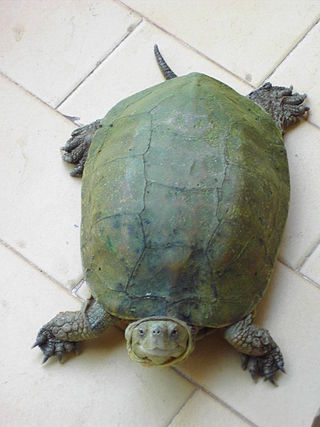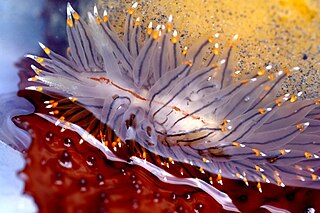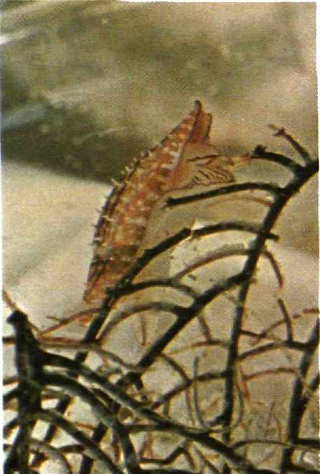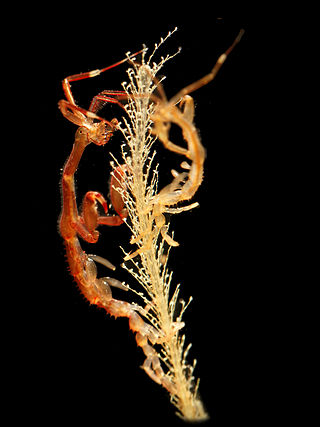
Mauremys is a genus of turtles in the family Geoemydidae.

Ferran Olivella Pons was a Spanish footballer who played as a defender.

Olivellinae, are a subfamily of small predatory sea snails with smooth, shiny, elongated oval-shaped shells, in the family Olividae. The shells sometimes show muted but attractive colors, and may have some patterning.

Janolus fuscus is a species of sea slug, or more accurately a nudibranch, a marine gastropod mollusk in the family Proctonotidae.

Olivella, common name the dwarf olives, is a genus of small predatory sea snails, marine gastropod molluscs in the subfamily Olivellinae of the family Olividae, the olives. Olivella is the type genus of the family.
Aforia moskalevi is a species of sea snail, a marine gastropod mollusk in the family Cochlespiridae.

Paralepetopsis lepichoni is a species of sea snail, a true limpet, a marine gastropod mollusk in the family Neolepetopsidae, one of the families of true limpets. It is part of the subclass of Gastropoda called Vetigastropoda.
Choristella hickmanae is a species of sea snail, a marine gastropod mollusk in the family Lepetellidae.

Homalocantha anatomica is a species of sea snail, a marine gastropod mollusk in the family Muricidae, the murex snails or rock snails.
Olivella arionata is a species of small sea snail, marine gastropod mollusk in the subfamily Olivellinae, in the family Olividae, the olives. Species in the genus Olivella are commonly called dwarf olives.

Olivella careorugula is a species of small sea snail, marine gastropod mollusk in the subfamily Olivellinae, in the family Olividae, the olives. Species in the genus Olivella are commonly called dwarf olives.

Olivella hyphala is a species of small sea snail, marine gastropod mollusk in the subfamily Olivellinae, in the family Olividae, the olives. Species in the genus Olivella are commonly called dwarf olives.

Olivella klappenbachi is a species of small sea snail, marine gastropod mollusk in the subfamily Olivellinae, in the family Olividae, the olives. Species in the genus Olivella are commonly called dwarf olives.
Olivella santacruzence is a species of small sea snail, marine gastropod mollusk in the subfamily Olivellinae, in the family Olividae, the olives. Species in the genus Olivella are commonly called dwarf olives.

Phenacovolva lahainaensis is a species of sea snail, a marine gastropod mollusc in the family Ovulidae, the ovulids, cowry allies or false cowries. It was originally discovered alive on black coral on the coast of the island of Maui.

Caprella mutica, commonly known as the Japanese skeleton shrimp, is a species of skeleton shrimp. They are relatively large caprellids, reaching a maximum length of 50 mm (2.0 in). They are sexually dimorphic, with the males usually being much larger than the females. They are characterized by their "hairy" first and second thoracic segments and the rows of spines on their bodies. Body color ranges from green to red to blue, depending on the environment. They are omnivorous highly adaptable opportunistic feeders. In turn, they provide a valuable food source for fish, crabs, and other larger predators. They are usually found in dense colonies attached to submerged man-made structures, floating seaweed, and other organisms.

The San Joaquin kit fox is an endangered species of fox that was formerly very common in the San Joaquin Valley and much of Central California. As an opportunistic hunter, the San Joaquin kit fox primarily preys on kangaroo rats but also targets white-footed mice, pocket mice, ground squirrels, rabbits, and ground-nesting birds. During certain times of the year, especially when other food sources might be scarce, it will also consume insects. Its 1990 population was estimated to be 7,000. This subspecies is still endangered, after nearly 50 years of being on the Endangered Species List. Officially this subspecies was listed March 3, 1967. On September 26, 2007, Wildlands Inc. announced the designation of the 684-acre (2.77 km2) Deadman Creek Conservation Bank, which is intended specifically to protect habitat of the San Joaquin kit fox. However, the population continues to decline mostly due to heavy habitat loss. Other factors include competition from red fox, and the extermination of the gray wolf from California has left the coyote as the dominant meso-predator in kit fox territory bringing an imbalance in ecosystem relationships. Sarcoptic mange has also constituted a significant threat, specifically to the Bakersfield population of the subspecies, with 15 confirmed cases reported by the end of 2014.

The Veliger was a peer-reviewed scientific journal covering malacology. The journal was established in 1958 and published its last issue in September, 2014. It was published by the California Malacozoological Society and Northern California Malacozoological Club.

Brachiaria mutica is a species of grass known by the common names para grass, buffalo grass, Mauritius signal grass, pasto pare, malojilla, gramalote, parana, Carib grass, and Scotch grass. Despite its common name California grass, it does not occur in California; it is native to northern and central Africa and parts of the Middle East, where it is cultivated for fodder. It was introduced elsewhere and it is now cultivated throughout tropical regions of the world for this purpose.

Walter Narchi was a Brazilian marine biologist. He mainly researched the anatomy of bivalvia and from 1960 to 2004 wrote over 60 papers, some with original descriptions of new species of this class.
















